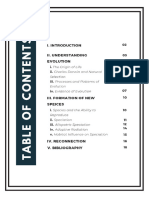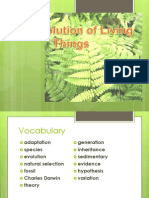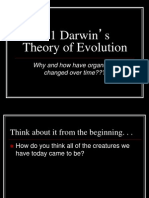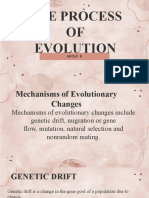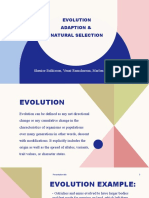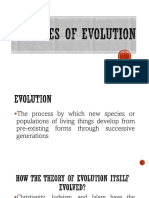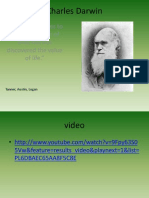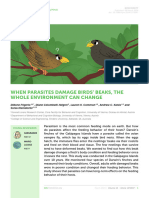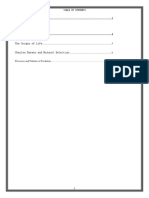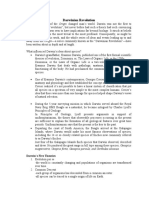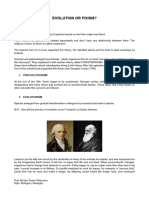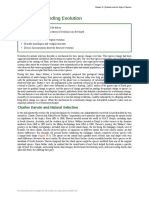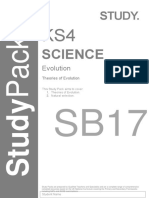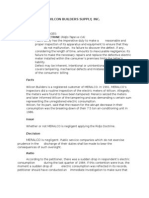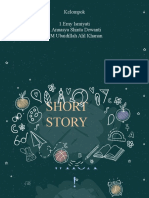Artificial Selection
Artificial Selection
Uploaded by
Juan Carlos RebolledoCopyright:
Available Formats
Artificial Selection
Artificial Selection
Uploaded by
Juan Carlos RebolledoOriginal Title
Copyright
Available Formats
Share this document
Did you find this document useful?
Is this content inappropriate?
Copyright:
Available Formats
Artificial Selection
Artificial Selection
Uploaded by
Juan Carlos RebolledoCopyright:
Available Formats
Artificial Selection
Artificial selection is the identification by humans of desirable traits in plants and
animals, and the steps taken to enhance and perpetuate those traits in future
generations. Artificial selection works the same way as natural selection, except
that with natural selection it is nature, not human interference, that makes these
decisions.
In laying out the evidence for his theory of evolution by natural selection in his 1859
book, On the Origin of Species, the British naturalist and biologist Charles Darwin
highlighted the physical traits and behaviors of several species of bird called
finches. During a voyage in the 1830s, Darwin had observed these birds on the
Galápagos Islands, a group of islands in the Pacific Ocean west of South America.
Sometimes summed up by the phrase “survival of the fittest,” natural selection is
based on the following principles: In nature, organisms produce
more offspring than are able to survive and reproduce. Offspring with traits that
make them more likely to survive, mature, and reproduce in the environment they
inhabit pass on their traits to the next generation.
As this happens generation after generation, natural selection acts as a kind of
sieve, or a remover of undesirable traits. Organisms therefore gradually become
better-suited for their environment. If the environment changes, natural selection
will then push organisms to evolve in a different direction to adapt to their new
circumstances.
How does this relate to finches? On the Galápagos Islands, some finches
appeared so different from others that Darwin did not realize at first that they were
all finches. In fact, they were different species of finches with a variety of traits.
Some finches, for instance, had long, narrow beaks, while others had short, thick
beaks. Darwin concluded that the traits of the different populations of finches had
changed over time, and that these variations were related to different environments
in the islands. Each type of beak had evolved for a specific task. Where there was
a large supply of seeds on the ground, for instance, short-beaked finches became
more common, because these beaks were better at cracking open the seeds.
Where cactus plants were more common, finches developed long, narrow beaks to
extract pollen and nectar from cactus flowers.
Darwin’s finches constituted powerful evidence for natural selection. But Darwin
was also inspired greatly by the evolution that he saw in the traits of pigeons, not
due to natural selection but rather artificial selection. Breeding pigeons was a
popular hobby in England in Darwin’s time. By selecting which pigeons were
allowed to mate, people had a profound effect on their appearance, such as the
shape and size of their beaks and the color of their feathers.
Dog breeding is another prime example of artificial selection. Although all dogs are
descendants of the wolf, the use of artificial selection has allowed humans to
drastically alter the appearance of dogs. For centuries, dogs have been bred for
various desired characteristics, leading to the creation of a wide range of dogs,
from the tiny Chihuahua to the massive Great Dane.
Artificial selection has long been used in agriculture to produce animals and crops
with desirable traits. The meats sold today are the result of the selective breeding
of chickens, cattle, sheep, and pigs. Many fruits and vegetables have been
improved or even created through artificial selection. For example, broccoli,
cauliflower, and cabbage were all derived from the wild mustard plant through
selective breeding. Artificial selection appeals to humans since it is faster than
natural selection and allows humans to mold organisms to their needs.
590 WORDS
You might also like
- Introduction To Artificial Intelligence: Fiona FrenchDocument31 pagesIntroduction To Artificial Intelligence: Fiona FrenchNipuniNo ratings yet
- A Raisin in The Sun DLPDocument10 pagesA Raisin in The Sun DLPJane Macababbad Tungcul100% (1)
- Chapter 15 - EvolutionDocument30 pagesChapter 15 - Evolutionnancie8No ratings yet
- Lesson Plan Pob MarketingDocument6 pagesLesson Plan Pob Marketingapi-461137051No ratings yet
- 1190 A Bird With Many Beaks 0Document8 pages1190 A Bird With Many Beaks 0poon.davonnaNo ratings yet
- Theory of Evolution by Natural Selection Part 1Document5 pagesTheory of Evolution by Natural Selection Part 1tileshadowNo ratings yet
- Cornell Notes CH 7Document2 pagesCornell Notes CH 7Aaron WongNo ratings yet
- Mechanism of Evolution: Charles DarwinDocument10 pagesMechanism of Evolution: Charles DarwinChristine FayeNo ratings yet
- Natural Selection Concept Map and JigSaw ReadingDocument8 pagesNatural Selection Concept Map and JigSaw ReadingGabe San AgustínNo ratings yet
- Evo (2) - Removed - MergedDocument18 pagesEvo (2) - Removed - Mergedspranesh409No ratings yet
- Biological EvolutionDocument54 pagesBiological EvolutionMa. Krizia Tiny ParconNo ratings yet
- Charles Darwin and Natural Selection PowerPoint For Web QuestDocument43 pagesCharles Darwin and Natural Selection PowerPoint For Web QuestPauline de LavalléeNo ratings yet
- E-Portfolio AnthropologyDocument5 pagesE-Portfolio Anthropologyapi-219299354No ratings yet
- The Evolution of Living ThingsDocument52 pagesThe Evolution of Living Thingsapi-234480965No ratings yet
- Articial SelectionDocument7 pagesArticial SelectionJohn AceNo ratings yet
- Darwin's Theory of EvolutionDocument3 pagesDarwin's Theory of EvolutionSai Yaswanth SagalaNo ratings yet
- Examples of EvolutionDocument3 pagesExamples of Evolutiongabrielluis08No ratings yet
- General Biology 2 PowerPointDocument49 pagesGeneral Biology 2 PowerPointRob MaraviveNo ratings yet
- EvolutionDocument14 pagesEvolutionbhavyashreemaggoNo ratings yet
- Bio (Bryan)Document1 pageBio (Bryan)chierryroseNo ratings yet
- Natural SelectionDocument2 pagesNatural Selectionvasi04No ratings yet
- Darwin To PostDocument60 pagesDarwin To Postapi-235073883No ratings yet
- Y6Evolution DarwinsFinchesDocument3 pagesY6Evolution DarwinsFinchesCyrus Flores,No ratings yet
- Biology Scholarship 2023Document11 pagesBiology Scholarship 2023Rocco ConaghanNo ratings yet
- Natural Selection vs. Selective Breeding: (Environmental)Document41 pagesNatural Selection vs. Selective Breeding: (Environmental)Miloš Če DragićevićNo ratings yet
- Evolution Day 6Document19 pagesEvolution Day 6Marlon MccarthyNo ratings yet
- 6.1 Darwin's Theory of Evolution: Why and How Have Organisms Changed Over Time???Document35 pages6.1 Darwin's Theory of Evolution: Why and How Have Organisms Changed Over Time???Diya SaherNo ratings yet
- Charles Darwin's Finches - Science ClassDocument10 pagesCharles Darwin's Finches - Science ClassHellen MaldonadoNo ratings yet
- EvolutionDocument1 pageEvolutionkim bechaydaNo ratings yet
- Darwin's Theory of Natural SelectionDocument3 pagesDarwin's Theory of Natural SelectionSteve SmithNo ratings yet
- Biology - Mod3:4 Summary (Not Done)Document14 pagesBiology - Mod3:4 Summary (Not Done)LilyNo ratings yet
- 15-1 Darwins TheoryDocument15 pages15-1 Darwins Theoryapi-342334216No ratings yet
- g8 Earth and LifeDocument47 pagesg8 Earth and LifelovelyNo ratings yet
- Darwins FinchesDocument3 pagesDarwins Finchesapi-250788203No ratings yet
- Evolution Cycle 7 Day 6Document19 pagesEvolution Cycle 7 Day 6Marlon MccarthyNo ratings yet
- Theories of Evolution PDFDocument23 pagesTheories of Evolution PDFDivine GhagaNo ratings yet
- DarvinismDocument1 pageDarvinismLia KuljanishviliNo ratings yet
- Reviewer ENVIRONMENTAL SCIENCEDocument7 pagesReviewer ENVIRONMENTAL SCIENCEAleah Angeli G. BuscadoNo ratings yet
- Life Heritable Traits Biological Populations Generations Biological Organisation Species Organisms MoleculesDocument8 pagesLife Heritable Traits Biological Populations Generations Biological Organisation Species Organisms MoleculesCMG RainNo ratings yet
- What Is Darwins Theory of EvolutionDocument5 pagesWhat Is Darwins Theory of EvolutionRakesh MeherNo ratings yet
- 3 F IfeDocument9 pages3 F IfemarinkaNo ratings yet
- Charles Darwin: "A Man Who Dares To Waste One Hour of Time Has Not Discovered The Value of Life."Document46 pagesCharles Darwin: "A Man Who Dares To Waste One Hour of Time Has Not Discovered The Value of Life."Dylan TerryNo ratings yet
- Frym 12 1272047Document8 pagesFrym 12 12720474143No ratings yet
- Click Here To Enter TextDocument20 pagesClick Here To Enter Textspranesh409No ratings yet
- Artificial SelectionDocument13 pagesArtificial Selectionvindhya shankerNo ratings yet
- Puntos Más ImportantesDocument13 pagesPuntos Más ImportantesRoger EspinozaNo ratings yet
- Darwinian Revolution: Darwin's Five TheoriesDocument3 pagesDarwinian Revolution: Darwin's Five TheoriesMatti NoNo ratings yet
- EvolutionDocument14 pagesEvolutionARYAGARA KRISTANDY RUKMANA PUTRANo ratings yet
- Fixism and Evolution.Document6 pagesFixism and Evolution.aliciared09No ratings yet
- Evolution and Natural Selection Education Presentation in 0 Hand Drawn Lightly Textured StyleDocument21 pagesEvolution and Natural Selection Education Presentation in 0 Hand Drawn Lightly Textured StyleGianella ChávezNo ratings yet
- 18.1 Understanding Evolution: Charles Darwin and Natural SelectionDocument9 pages18.1 Understanding Evolution: Charles Darwin and Natural Selectionklavier10244379No ratings yet
- The Process of EvolutionDocument23 pagesThe Process of EvolutionAixy BaldamorNo ratings yet
- Is A Characteristic That Helps An Organism Survive and Reproduce in Its EnvironmentDocument3 pagesIs A Characteristic That Helps An Organism Survive and Reproduce in Its EnvironmenthhavrishNo ratings yet
- Darwin's Theory of Evolution ?Document13 pagesDarwin's Theory of Evolution ?Dark mayersNo ratings yet
- Charles Darwin Theory of Evolution NEWDocument16 pagesCharles Darwin Theory of Evolution NEWjetlee estacionNo ratings yet
- SB 17 EvolutionDocument36 pagesSB 17 EvolutionGeo GeoNo ratings yet
- Darwin's Theory of EvolutionDocument3 pagesDarwin's Theory of EvolutionZephyr PhillipsNo ratings yet
- Thesis Land SnailDocument6 pagesThesis Land Snailtammylacyarlington100% (1)
- SoftComputing Unit4 GeneticAlgorithmsDocument382 pagesSoftComputing Unit4 GeneticAlgorithmsKonakalla SrijaNo ratings yet
- Science Adaptation Study GuideDocument2 pagesScience Adaptation Study GuideBitancor JemimaNo ratings yet
- Evolution and Natural SelectionDocument22 pagesEvolution and Natural SelectionmalikNo ratings yet
- Darwin's TheoryDocument7 pagesDarwin's TheoryAbdelrahman MohamedNo ratings yet
- Review Article: Caffeic Acid Phenethyl Ester and Therapeutic PotentialsDocument10 pagesReview Article: Caffeic Acid Phenethyl Ester and Therapeutic PotentialsDwi wahyuniNo ratings yet
- Intersubjectivity Part 2Document46 pagesIntersubjectivity Part 2Lance HabocNo ratings yet
- Educational Informatics Policy in ChileDocument4 pagesEducational Informatics Policy in ChileAna Magdalena Díaz AngelNo ratings yet
- Pediatric and Adolescent GynecologyDocument11 pagesPediatric and Adolescent GynecologyAndrea GuidoteNo ratings yet
- Soal Toefl Read 3-DikonversiDocument32 pagesSoal Toefl Read 3-DikonversiLailareza ShintiaNo ratings yet
- Certified List of Candidates For Congressional and Local Positions For The May 13, 2013 2013 National, Local and Armm ElectionsDocument2 pagesCertified List of Candidates For Congressional and Local Positions For The May 13, 2013 2013 National, Local and Armm ElectionsSunStar Philippine NewsNo ratings yet
- Summary of IndigoDocument2 pagesSummary of IndigoAditya Kiran100% (1)
- DRDFGYJBHDocument5 pagesDRDFGYJBHmarie joyce almayanNo ratings yet
- Medical Ward Journal ReadingDocument4 pagesMedical Ward Journal ReadingFrances MercadoNo ratings yet
- Meralco Vs Wilcon BuildersDocument2 pagesMeralco Vs Wilcon BuildersBAROPSNo ratings yet
- An Introduction To Consumer BehaviorDocument18 pagesAn Introduction To Consumer Behaviorkes7No ratings yet
- Ochoa vs. Apeta G.R. No. 146259Document3 pagesOchoa vs. Apeta G.R. No. 146259Hannah Keziah Dela CernaNo ratings yet
- 1. Digested Prudencio B. Portuguese Jr. vs. Atty. Jerry B. Centro a.C. No. 12875. January 26 2021Document2 pages1. Digested Prudencio B. Portuguese Jr. vs. Atty. Jerry B. Centro a.C. No. 12875. January 26 2021Kathleen MarcialNo ratings yet
- 13 Day Program IndiaBhutan2014Document14 pages13 Day Program IndiaBhutan2014jambayTDNo ratings yet
- Smart Money,' by Andrew Palmer - NYTimes PDFDocument3 pagesSmart Money,' by Andrew Palmer - NYTimes PDFDylan AdelmanNo ratings yet
- Austin Journal of Nephrology and HypertensionDocument4 pagesAustin Journal of Nephrology and HypertensionAustin Publishing GroupNo ratings yet
- Serious Leisure and MountaineeringDocument3 pagesSerious Leisure and Mountaineering1237957No ratings yet
- Verbalizes Awareness of Causative Factors and Behaviors Essential To Correct Fluid DeficitDocument6 pagesVerbalizes Awareness of Causative Factors and Behaviors Essential To Correct Fluid DeficitAlecxia Nicole PernitoNo ratings yet
- An African Voice - Assgined ReadingDocument1 pageAn African Voice - Assgined ReadingChiranjib ParialNo ratings yet
- GUIDELINES FOR PREPARATION OF OIL SPILL RESPONSE CONTINGENCY PLAN OISD - GUIDELINES-200 Amended Edition October 2002 - OISD-GDN-200Document36 pagesGUIDELINES FOR PREPARATION OF OIL SPILL RESPONSE CONTINGENCY PLAN OISD - GUIDELINES-200 Amended Edition October 2002 - OISD-GDN-200Vaishnavi JayakumarNo ratings yet
- 27 Top Freedom Bible Verses - Scripture About Being Free!Document6 pages27 Top Freedom Bible Verses - Scripture About Being Free!Daion MarshallNo ratings yet
- Claudio Vita-Finzi-A History of The Solar SystemDocument110 pagesClaudio Vita-Finzi-A History of The Solar SystemAnonymous 0LxzQQgRNo ratings yet
- Internal Conflict and Governance (Kumar Rupesinghe (Eds.) ) (Z-Library)Document321 pagesInternal Conflict and Governance (Kumar Rupesinghe (Eds.) ) (Z-Library)AntenehMeluNo ratings yet
- MM1 Assignment 16-18 Group7Document8 pagesMM1 Assignment 16-18 Group7Prateek SinghaniaNo ratings yet
- Domain Driven Design - Step by StepDocument34 pagesDomain Driven Design - Step by StepLuke Vindicare0% (1)
- Sastra Inggris Kelompok 4Document11 pagesSastra Inggris Kelompok 4bye xNo ratings yet
- Books Dictionaries 1Document4 pagesBooks Dictionaries 1socratesNo ratings yet









